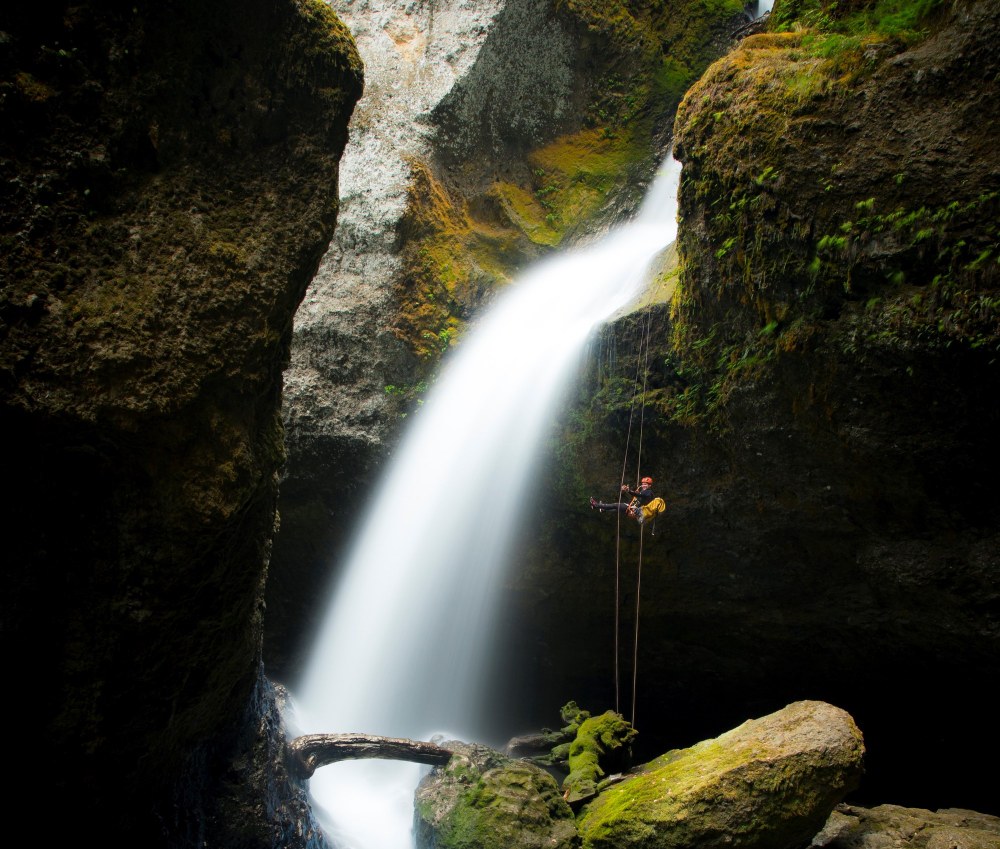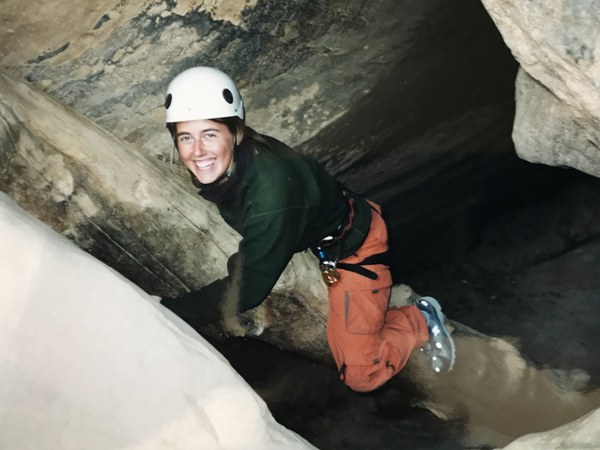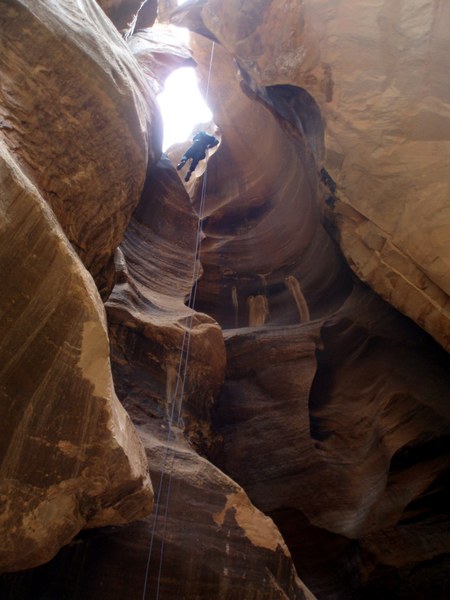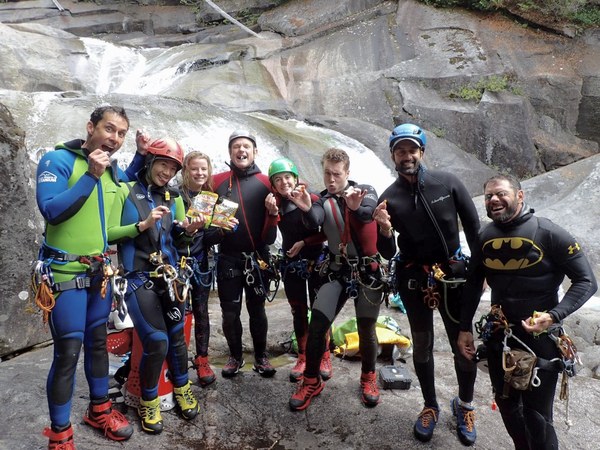
In November of 2001, my friend Stacy and I began our regular journey eastward, heading home to our respective states of Tennessee and Connecticut after a season of teaching Outdoor Education in California. We were both excited to visit Zion National Park on the way home for a few weeks of exploration. Both climbers in our 20’s, Stacy and I hoped to rappel through a slot canyon.
As soon as we arrived, the backcountry rangers helped us plan our backpack trip and advised us to get properly outfitted to hike the Virgin River Narrows at Zion Adventure Company (possibly the only guide service in town at that time). After setting us up with dry suits and shoes for The Narrows, the kind folks at Zion Adventure answered our many questions and recommended Pine Creek Canyon. Pine Creek is a straight-forward, well-traveled canyon, and it happened to be bone dry, which eliminated the risks that come with cold water.
We parked our car at the canyon exit, grabbed our gear, and
stuck our thumbs out along with an 8.5’x11” homemade
“Pine Creek Canyon” sign. Friendly wildland firefighters
picked us up in their truck, drove us through the Zion-
Mt. Carmel tunnel, and dropped us off at the top of the
canyon. Having since done Pine Creek another half-dozen
times over the years, I know that we totally botched the
entrance. We couldn’t figure out how to navigate the first
two potholes, so we scrambled up along the scree slope,
doing our best to avoid stepping on the cryptobiotic soil,
and rappelled off a tree into the heart of the canyon. We
pulled the rope and were committed.
Into the slot
The canyon was stunning and silent - not a soul around.
A short, awkward rappel or two led us to a drop without
an anchor, just a large log spanning from the edge of the
drop, 20’ to the bottom. “All adventure all the time” was
our motto, taken from the Ventura radio “all hits all the
time” station we’d listened to all season. We looked at the
log skeptically, shrugged, and one after the other shimmied
about 20-feet down the log to the bottom of the drop.

We rounded a sketchy, sloped corner to find a stunning
amphitheater with incredible sandstone formations. We
had entered the Great Cathedral, a magical place few ever
experience. We rappelled to the sandy bottom, totally
unaware that most of the year the cathedral rappel ends in
a pool so deep you can’t touch the bottom. We pulled our
rope, sat down on the sand, and took in the fluted walls, the
natural arch, and the impressive alcove of the cathedral.
The Great Cathedral is followed by a long, deep corridor
that can feel subterranean. The slot is 100-feet deep and
only about 30-feet wide, and doesn’t get much sun. But
at the right time of day, the light plays beautifully on the
sandstone walls carved by water and stone. As we exited
the slot, the canyon opened up and we could see views
across the valley. We noticed another party at the top of
the final rappel up ahead, so we found a perch in the sun
where we sat and snacked and read Edward Abbey aloud to
one another.
I felt a deep connection to this place, and gratitude for the
opportunity to experience it.
With the other party out of sight, we rigged our rope for
the final rappel. This rappel is 95-feet and free-hanging,
through what is possibly one of the most beautiful works of
art Mother Nature has ever crafted. The only way a person
can experience that beautifully carved sandstone is by
practicing the sport Stacy and I had just been introduced
to: canyoneering*.
For the next 15 years, I made a nearly annual pilgrimage to
Zion. I was drawn by the desire to explore these spectacular
hidden places overlooked by landscape photos and view-seekers.
These special places hold secrets of the powerful
forces, hidden ecosystems, and endless variety of the earth.
Each canyon I experienced was magical in its own way,
and I found great joy in sharing those special places with
friends. Even repeating canyons I had done before was a
new experience. Canyons change so much with each year’s
floods, so there was always an element of exploration and
newness - new obstacles, new anchors. These ever-changing
environments offer a humbling perspective of the powerful
natural forces that shape the earth.
 Pine Creek, Zion National Park, UT. Photo by Becca Polglase.
Pine Creek, Zion National Park, UT. Photo by Becca Polglase.
Aquatic canyoning
When I moved to Washington, I discovered that desert
slots are just one type of canyon. In the Pacific Northwest,
and, incidentally, in Europe, New Zealand, and many other
mountainous regions in the world, aquatic canyoning is the
sport of descending canyons with flowing water. It was hard for me to imagine how creeks flowing through a hard rock
like granite could possibly compare to the deep, carved
sandstone slots. But with just a single descent of Box Creek
in Squamish, my mind was officially blown. Towering granite
walls, deep blue pools, stunning waterfalls, and colorful rock
stained deep red, presumably by tannins from the water
table, made my experience in Box as life-changing as that
first time in Pine Creek. This, too, was a beautiful, magical,
hidden place full of natural wonder, perhaps even more
spectacular than the desert slots.
Good fortune led me to an aquatic canyoning* course
offered by Canyoning Colorado in the small mountain
town of Ouray. The moving water obviously adds plenty
of elements of risk that don’t exist (or exist to a much
lesser extent) in desert slots - not the least of which are
drowning and hypothermia. It requires a knowledge of
ropecraft, rigging, and teamwork that is very different
from that required by desert slots. I found it exciting, scary,
empowering, and intellectually stimulating. I was hooked.
When I returned home to the PNW, I discovered perhaps
the best aspect of all: community. Suddenly my world of
canyoning expanded tenfold. No longer did I have to travel
to the desert to explore canyons or push my canyoning
hobbies on my friends. I found myself living within a
community of canyoneers, surrounded by local canyons.

The magical first canyon experience I had in Pine Creek and
my first aquatic canyon experience in Box will always carry
with them a sense of wonder and awe that can only occur on one’s first experience with something new. But I have found
that each canyon provides something special and wonderful.
In Dingford Creek in 2018, I pushed my comfort level with high-volume water, and in 2019 in that same canyon, I experienced
the camaraderie of a highly efficient and supportive team.
Big Creek was humbling in its beauty and scale, and Magic
Box Creek offered a unique wilderness experience with
new challenges and an outstanding team. Cypress Creek is
playful, with fun, easy jumps into pools, and Quicksilver Creek
offers complex rigging and a natural slide. The list goes on.
An undiscovered community
Canyoning is a sport that has something for everyone,
and in the Pacific Northwest community, there’s a place
for everyone. There are low-flow canyons for those who
don’t love water, and big water canyons for those who love
swimming and rappelling in the flow. Some of our canyons
are very committing - with no escape routes once you’re
in them. Others have a more open profile, but are equally
beautiful. There are canyons with multi-pitch rappels and
canyons with technical rigging. Others have big jumps and
slides. Each canyon offers its own type of beauty - whether
it's colorful rock, lush green corridors, deep blue pools,
sculptured slots, or expansive views, and each offers a
perspective you simply cannot get from anywhere else.
In aquatic canyons especially, a canyon descent is a team
effort. A rigger may need to be belayed to reach an exposed
anchor. The first person to descend needs an attentive
teammate at the anchor in case they need more rope, or
if they get into trouble in the flow and need to be rescued.
The last person down must successfully de-rig the anchor
and pull the rope without getting it stuck. A stuck rope
could strand a party in a canyon. Other members of the
team must jump in to help sort gear, bag the rope, and
transport gear to the next drop. Teamwork is necessary in
downclimbs, slides, and jumps. Partner assists are common
in downclimbing, and a human anchor can be used to lower
someone to check a pool depth before the rest of the team
jumps or slides.
Every person on the team has an important role, and
teammates keep eyes on one another and ensure everyone is moving safely, staying fed and hydrated. The necessity
of teamwork, the shared successes and challenges, the
funny commentary, and the shared discovery of unexpected
beauty around the corner all lead to fast friendships. Most
will agree that the best canyon days are not a function of
the canyon, but the team you’re with.
 A Mountaineers Canyon Team in Dingford Creek, WA. Photo by Becca Polglase.
A Mountaineers Canyon Team in Dingford Creek, WA. Photo by Becca Polglase.
This decade and the next are a special time for canyoning
in the Pacific Northwest. We have world-class canyons with
deep blue pools, endless waterfalls, sculpted granite, and
towering basalt walls. Canyoneers immerse themselves in
lush green corridors where ecosystems thrive, protected in
hanging gardens suspended above the harsh environment
of the canyon floor, yet inaccessible to human degradation.
Our community is young, relatively small, incredibly
welcoming, and supportive of one another. With about 230
established canyons - that is to say, canyons that have a
recorded descent - about half have been established since
2014. We are in a period of rapid exploration, and there
are still endless canyons in the PNW that have yet to be
explored. While there are a few “trade routes” that may see
two parties in a day, canyons in the PNW remain a place
where a party can find themselves alone, away from crowds.
Even as the sport grows, it’s likely to stay this way in all but
the most accessible canyons for quite some time.
While some skills from caving and climbing transfer to
canyoning, canyoning is not a sport one should take on
without training or mentorship. Proper training allows
canyoneers to be competent teammates, manage the
unique risks and hazards in a canyon environment, and
utilize low-impact methods of travel through a canyon.
In recent years, the PNW has seen the emergence of a
few courses, including those run by The Mountaineers.
Throughout the year, our community hosts practice
sessions that are open to anyone, which are a great way
to start connecting with the community. Regardless of your
skills or experience, canyoning in the Pacific Northwest
will connect you to incredible people, stunning places, and
new experiences. It’s a sport that continues to evolve with
new techniques and new destinations. Here in the PNW, a
magical first-time experience like I had in Pine Creek and
again in Box Canyon awaits anyone who seeks it, and a
lifetime of new canyon experiences and friendships await
even the most experienced of canyoneers.
*Canyoneering typically refers to the exploration of canyons in the American Southwest, while Canyoning is typically used to describe the descent of aquatic canyons.
Get Involved
Canyoning combines exploration, adventure, solitude, teamwork, and pure, unadulterated fun. A technical sport, it also requires training in its unique equipment and techniques. Our Seattle Canyoning Committee hosts courses and practice sessions throughout the year. Join us to expand your world of possibilities and connect with these spectacular places hidden in plain sight. https://www.mountaineers.org/locations-lodges/seattle-branch/committees/seattle-canyoning-committee
MAIN IMAGE of Cave Falls, Big Creek, WA. Photo by Jake Huddleston
This article originally appeared in our Summer 2020 issue of Mountaineer Magazine. To view the original article in magazine form and read more stories from our publication, visit our magazine archive.
 Becca Polglase
Becca Polglase